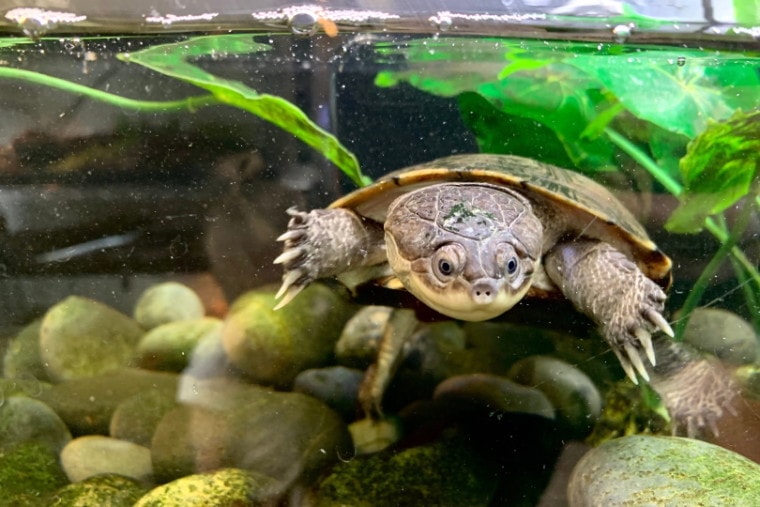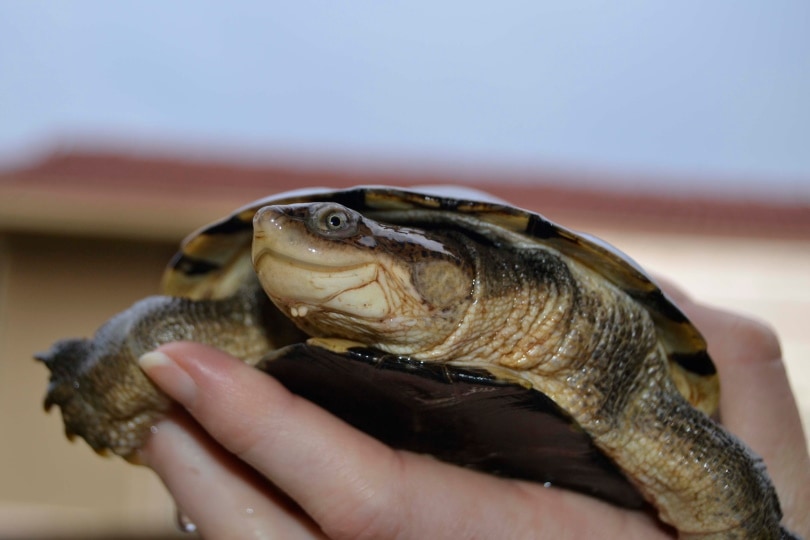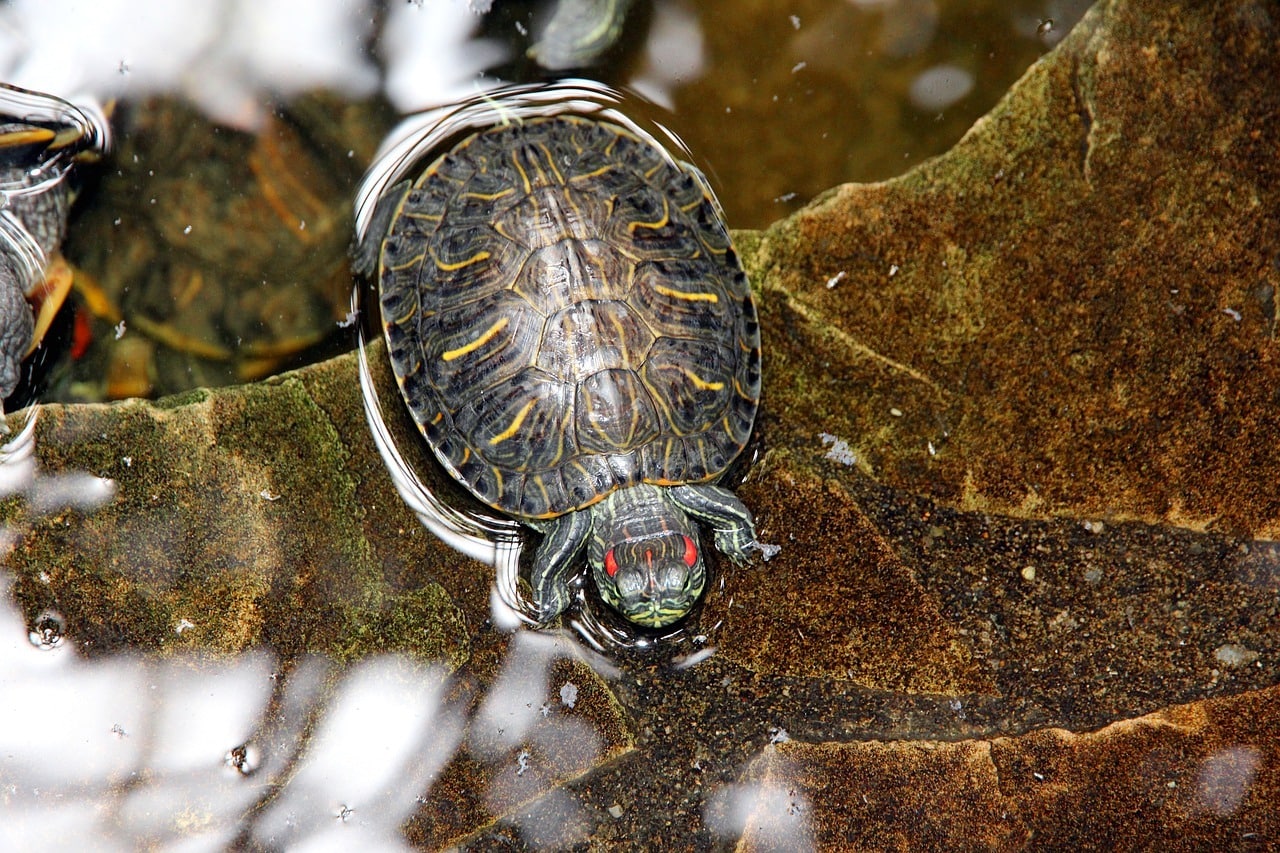
The seemingly smiling face of the African sideneck turtle makes it a popular pet with its owners. It gets its name because this unusual-looking aquatic turtle is unable to tuck its head in its shell, tucking it to the side instead. It can live for several decades, and although they are not the easiest aquatic pet to look after, they are still considered suitable for novices that are happy to put the extra work in.
Do be prepared for a long-term commitment, though, because the sideneck can live as long as 50 years when well cared for and given optimal living conditions.
 Quick Facts About the African Sideneck Turtle
Quick Facts About the African Sideneck Turtle
| Species Name | African sideneck turtle |
| Family | Pelomedusidae |
| Care Level | Moderate |
| Temperature | Water: 70°–75°F Basking: 95°–100°F |
| Temperament | Shy but inquisitive |
| Color Form | Dark with a grayish plastron |
| Lifespan | 20–50 years |
| Size | 8–12 inches |
| Diet | Omnivores |
| Minimum Tank Size | 75 gallons |
| Tank Set-Up | Tank, water, land, basking rock |
| Compatibility | Can live with other turtles and larger fish |
African Sideneck Turtle Overview

The African sideneck turtle comes from Africa and it has a face that is always welcoming, thanks to its big eyes and fixed smile.
The turtle gets its name from the way that it tucks its head. Because it cannot tuck its head all the way in, it has to tuck it underneath the shell, or to the side.
The sideneck is also known by the names African helmeted turtle, marsh terrapin, and the West African mud turtle.
They are small aquatic animals that, in the wild, have a life expectancy of around 25 years, although they can last twice as long when kept in captivity. They prefer to live in still water bodies like swamps and lakes. They may also live in shallow pools. In water, they reach speeds of up to 12 miles per hour, but they do not reach anywhere near this speed on land, only reaching a walking speed of about 4 mph when in a hurry.
In the wild, the turtle gets its nickname of the crocodile turtle because of the way that it sometimes attacks its prey. When it lives with a large group of other side necks, the group will attack prey including water birds. They will drag the prey underwater and attack it with their sharp claws. The commotion and the disturbance on the water are so great that the attack is often mistaken for a crocodile attack.
 How Much Do African Sideneck Turtles Cost?
How Much Do African Sideneck Turtles Cost?
Young turtles will cost between $50 and $100. When choosing one, ensure that you opt for one that is not showing signs of illness. Specifically, check the shell for signs of it being flaky or otherwise damaged. Ensure that the turtle is not overly lethargic and make sure that it is eating properly before you consider taking it home.
Typical Behavior & Temperament
Initially shy, the sideneck will eventually come out of its shell. In fact, once your sideneck has settled into its new home, it will become as inquisitive as a cat, which can sometimes be mistaken for aggression.
They can be perky little pets that will pop up to say hello and seemingly converse with you, but like all aquatic turtles, they should not be handled. Although they are not particularly known for their aggression towards humans, they can become scared or anxious, at which point they are prone to scratch and bite as a means of defense.
Appearance & Varieties
The skin color of the sideneck turtle can vary from tan to brown and even black. The head is a similarly dark color, typically brown, and the belly is a yellowish color.
The feet of the aquatic turtle are semi-webbed. This enables them to push themselves through the water much quicker, making swimming and underwater gliding much easier. They also have sharp and long claws on the end of those feet, used for hunting and killing in the wild.
Males have thicker tails. Females have broader shells.
One of the ways that this breed differs from other aquatic turtles is because its undershell is not hinged. This hinged shell allows other species to fully cover their heads, and the lack of hinging is the reason that the sideneck is unable to retract its head fully into its shell. However, where other breeds of turtle are unable to right themselves if they end up on their back, the sideneck has such a strong neck, it can thrash its neck back and forth and end up back on its feet.
How to Take Care of African Sideneck Turtles
Some species of African sideneck turtles are considered endangered and should be left in the wild. However, if you rescue one or end up with a sideneck turtle that is not on the endangered list, you will need the following setup.
Habitat, Tank Conditions & Setup
Tank
The sideneck turtle is aquatic and it will enjoy diving and turning underwater. It needs at least a 75-gallon tank and it should be at least half full of water. There should be some dry land, which can be provided with a rock or a dry dock area. You will need a good water filter because the turtles defecate in the water, which will also need changing every week to ensure your turtle remains healthy.
Heat
Offer a heat lamp and ensure that the tank has an ambient temperature of around 80°F with a basking area that is a little hotter, typically 90°F. Use a thermostat to monitor and manage temperature, ensuring that it does not drop too low even at night when the basking light is turned off.
Light
Provide a UVB light on a 12-hour cycle. This will mimic the day/night cycle that your turtle would enjoy in the wild and the UVB will help your sideneck get the required amount of UVB. In turn, vitamin D will help the sideneck synthesize calcium.
Substrate
A substrate isn’t essential to your turtle, and it can make cleaning the tank more difficult. However, it can also mimic some elements of the turtle’s natural surroundings. If you do offer a substrate, use sand, gravel, or another natural material.
Do African Sidenecks Get Along With Other Pets
African sidenecks will get along with other turtles of the same species. You can keep multiple sidenecks together, although you should be prepared for clutches of eggs if you do. They can also live with other species of turtle and can even live with larger fish. However, remember that small fish are part of the turtle’s diet, so be careful when putting turtles and fish in the same tank together.
The turtle should not be introduced to cats, dogs, or other types of animals, because a bad meeting can cause stress which can make your sideneck ill.
What to Feed Your African Sideneck Turtle
Like most other aquatic turtles, the African sideneck is an omnivore. This means that it eats just about anything. It will eat plants, insects, fish, and food pellets. In fact, pellets can be a beneficial source of food because they contain additional vitamins and minerals that might not be sourced from natural food.
Feed every 24 hours, let your turtle eat as much as it wants for around 30 minutes, and then remove uneaten food. If you leave food in for long, it will clog the water filter and cause problems for the water and the turtle.
Keeping Your Sideneck Turtle Healthy
Roundworms and other parasites are common in African sideneck turtles. Spotting signs is difficult which also makes them difficult to effectively treat. Have your turtle checked regularly by a specialist vet, and they will be able to conduct parasite screening for you.
Vitamin A deficiency is another common problem. Look for swelling around the eyes and seek veterinary help straight away if evident.
Shell rot, which starts as a bacterial infection, can cause painful ulcers on the shell.
Ensure that the water temperature is kept constant and that your turtle is provided with suitable food. Clean and change the water regularly to remove any unwanted materials and to ensure that your turtle is living in suitable water. Maintain ambient, water, and basking temperatures in the appropriate range, too, because if your turtle gets too hot or too cold, it can cause illness.
Breeding
When a male is ready to breed, he will bob his head at the female. If she is willing, the female will stand still or nod her head back. If she snaps and walks away, it means that she is not ready. The turtle can have multiple clutches in a year, lays up to 10 eggs per clutch, and the female will lay her eggs in a nest approximately 15 cm deep.
Interestingly, the sex of the young is determined by the temperature of the water. Warm and cold temperatures give female offspring, while moderate temperatures will yield mostly male turtles.
 Are African Sideneck Turtles Suitable for You?
Are African Sideneck Turtles Suitable for You?
The African sideneck turtle is an unusual aquatic turtle species, for many reasons, not least because it is unable to retract its head into its shell and the ultimate head resting position is what gives it the common name of sideneck turtle. It also has a seemingly fixed and permanent smile and it has earned the nickname crocodile turtle because, when hunting in groups in the wild, the commotion caused under the water makes it look like a crocodile attack.
Featured Image Credit: Megan Czarnocki, Shutterstock

 Quick Facts About the African Sideneck Turtle
Quick Facts About the African Sideneck Turtle How Much Do African Sideneck Turtles Cost?
How Much Do African Sideneck Turtles Cost?





